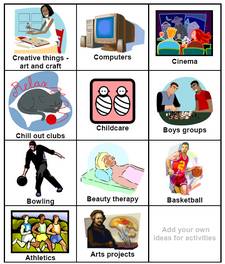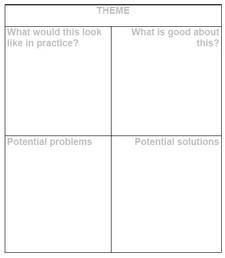[Summary: a quick linking list of social media & youth engagement resources, cross-posted from Youth Work Online]
I’ve just been running a short session at a meeting of the South East Participation Project around how different social media and social network sites can be used in youth participation. The session gave me an opportunity to put together some new slides and a list of resources capturing learning from recent projects about the need to look at more than just Social Network Sites – but to think about how a wide repertoire of tools and online facilitation approaches are brought together to support engagement and inclusion. You can view the slides below (may not make massive sense without the speaking with them – but hopefully give some insights) or scroll on for a list of links and resources.
We discussed a wide range of resources in the session, some of which I’ve tried to capture links to below.
Online tools

Video-making tools: powerful for ‘context-setting’ (explaining a participation opportunity); promoting projects; and as a way of capturing young people’s views and getting voices heard.
Useful links: Shared Practice Through Video guide; Example of video to promote projects; Discussion on using video; Suggested kit-list with cameras;

Survey tools: you can link people to online surveys – or some surveys can be embedded within Facebook and blogs to get structured input from young people. Think carefully about the design of online surveys.
Useful links: SurveyMonkey for online polls; Look for Poll and Voting applications to add to a Facebook page; SMSPoll for text-message surveys; Practical Participation can offer support designing and hosting online surveys; Google Forms also offers a free and effective way to create quick survey forms.

Online mapping tools: to communicate information, or for campaigning.
Useful links: the MyMaps feature on Google Maps (see the one page guide here) can be used for collaborative map making; Google Sketch Up can be used to make 3D models for Google earth; OpenStreetMap can generate free maps of your area for printing & working with; TacticalTech on Maptivism

Collaboration tools: for group work across distance.
Useful links: iEtherPad offers a quick-to-set-up places to collaborative write a document in real-time. Google Documents allows a group to all share and collaborate on spreadsheet(e.g. Budgets) or other documents. Zoho collaborative docs and Huddle collaboration space both have Facebook applications that let you create a ‘virtual office’ within Facebook for a project.

Social Network Sites can be the hub for many engagement projects. They provide a space to connect with young people; to share media from other tools; to promote opportunities to engage; to campaign for change and more.
Some local areas will have private ‘social networking spaces’ within the local authority or schools – such as SuperClubsPlus or RadioWaves which practitioners may wish to explore as environments to work with. If exploring engagement in the wider environment of existing social network sites then more links are below.
Working with social network sites:
There are many resources to help practitioners explore the use of social network sites such as Facebook. The following were mentioned in the workshop:
- Social Media, Youth Participation and Local Democracy – including sections on overcoming barriers to using social networks; case studies of practice; guidance on using listening and engagement tools; and section on using social media with children and young people in care.
- Online Youth Outreach from Katie Bacon includes a wealth of shared resources, policies, guides and tools.
- Check the pictures section of Youth Work Online for some flow-charts on responding to common challenges in social network practice
- Youth Engagement and Social Networking Guide – a draft and developing guide with Toolkit section on many different social media tools – including details on different ways of using social network sites. Also support on making the case for online engagement – and getting web blocks removed.
- Safe and Effective Engagement with Social Network Sites for Youth Practitioners
- Youth Work and Social Networking Report – sets out a theoretical and practice case for engaging with social networks.
On e-safety issues take a look at The Byron Review for the wider context, and resources from ChildNet such as Digizen.
For those exploring the development of applications Safe and Effective Social Network Site Applications might also be of interest.
If you have young people interested in Internet governance issues – check out the HuWY project.
Taking it further
The Youth Work Online network and the Network Participation networks are places to explore these issues more.
 I’m putting together a series of short guides for different clients on how to use social media tools in shared learning and online outreach. These will be a mash-up of my existing practical
I’m putting together a series of short guides for different clients on how to use social media tools in shared learning and online outreach. These will be a mash-up of my existing practical  Of course, local authorities and professionals working with young people have a duty not only to make sure young people are aware of the positive activities available to them, but also a duty to keep young people safe from harm – and Social Network Sites can be places of risk as well as of opportunity. Which is why public and third-sector organisations engaging with SNS shouldn’t just copy the ‘viral marketting’ and often aggressive tactics of commercial SNS application builders – but need to develop a clear ethical and risk assessment framework for engaging with Social Network Sites.
Of course, local authorities and professionals working with young people have a duty not only to make sure young people are aware of the positive activities available to them, but also a duty to keep young people safe from harm – and Social Network Sites can be places of risk as well as of opportunity. Which is why public and third-sector organisations engaging with SNS shouldn’t just copy the ‘viral marketting’ and often aggressive tactics of commercial SNS application builders – but need to develop a clear ethical and risk assessment framework for engaging with Social Network Sites. Unpacking the reasons why we need to treat young people differently;
Unpacking the reasons why we need to treat young people differently; I recently co-designed and fascilitated a series of dialogue events for
I recently co-designed and fascilitated a series of dialogue events for  We used this set of 10 ‘Local Offer Bingo’ cards as our ice-breaker name-game.
We used this set of 10 ‘Local Offer Bingo’ cards as our ice-breaker name-game. These cards add a bit of colour, and list all 47 of the activities used in Local Offer Bingo along with a suitable clip-art image.
These cards add a bit of colour, and list all 47 of the activities used in Local Offer Bingo along with a suitable clip-art image. This is a really simple tool – and I was suprised by how well it worked.
This is a really simple tool – and I was suprised by how well it worked.